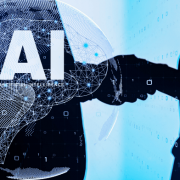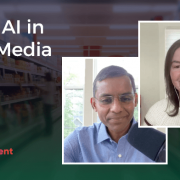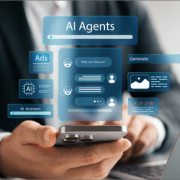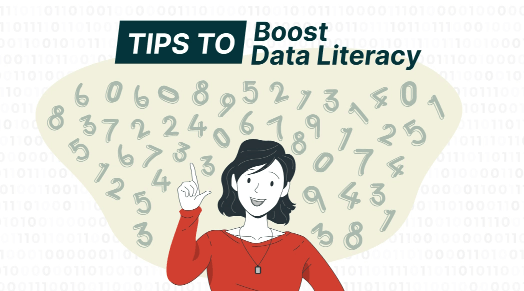Our data universe has witnessed a colossal year-on-year growth of 42.2% worldwide1. IDC predicts that the Global Datasphere will grow from 80 Zettabytes in 2022 to 175 Zettabytes by 20252. With such growth also comes the responsibility of making information easily accessible and interpretable across a range of users that includes customers, business partners, and employees.
Business leaders often speak about the lack of value realization from data analytics projects. They understand that technology enabled innovation opens a world of opportunities, but business benefits are elusive owing to poor enterprise data awareness and lack of adoption.
While this problem is common, businesses are yet to focus on data literacy as a fundamental skill at their workplaces. In the absence of data literacy, enterprises often encounter challenges like miscommunication between departments owing to different data definitions, risk of data breaches, and untapped business improvement opportunities – despite having technical capabilities in their portfolio.
You must recognize that not only data and analytics skills, but also access to the right tools and quality data along with a supportive culture will together help build a data-first mindset. Finally, to permeate the culture across all levels in the organization, it is essential to provide the right change management interventions to nourish data literacy initiatives over sustained periods of time.
With our experience in helping our clients improve data literacy within their enterprises, we have identified six essential factors that organizations should consider as they go about data literacy initiatives:
-
Assess your data literacy score – Poor understanding of data is most often attributed to knowledge gaps. So, in defining your business case to launch a data literacy campaign, get a baseline of the current knowledge levels and skill gaps in your workforce. In addition, quantifying data literacy levels helps construct your program design aligned to your organization culture.
Not every style of training is suitable across age groups or varying functional needs. While working with an APAC luxury retail client, Infocepts was able to identify the training needs within each department, translated that to a pilot program and then expanded the model to a multi-country rollout.
-
Ensure executive management sponsorship – Driving change management isn’t easy; it’s no different in ushering culture change pertaining the usage of data. To orchestrate full support from C-suite management at the start of your program it is essential to articulate the following, rather than focusing on platform capabilities alone:
- The business case – a clear visibility of value expected to be delivered and against which organization wide investments are required
- Roles and responsibilities – it is imperative to establish the bandwidth required to launch and sustain the program, for both key roles and other stakeholders
- Benefits realization – we need to communicate well on how the performance metrics will shift across departments (e.g., turnaround time improvement for customer service)
- Committed timelines – the program should be designed to deliver quick wins, rather than accrue value at the end of long-time intervals.
It’s also critical to convey that data literacy won’t thrive simply by purchasing new software or a having a large team of specialized data scientists address all the needs of a workforce numbering in the thousands.
While engaging with one of our client’s, a global bank, Infocepts identified poor data quality as one of the limiting factors for adoption and literacy among users due to lack of trust in data. Fixing this problem required executive interventions to prioritize data quality improvement initiatives across functions in addition to helping users adopt self-service through focused data literacy programs.
-
Data visualizations empower literacy – One size doesn’t fit all when it comes to evangelizing the language of data across a large user base. A quick win is to teach users the power of data visualizations, enabling them to graduate from static spreadsheets to their own “passion projects” now available to them through enhanced analytical tools. Given such empowerment, the usual result is that—on their own—users now discover white spaces and data patterns that were hitherto unknown.
But ease of access to relevant datasets is imperative for this to occur.
Across multiple engagements, one of the lessons we learned is that while job function does matter, at times even the most junior employees are able to churn out Sankey diagrams that explain cash flows—while middle levels are satisfied with the bare minimum aggregate information.
Both risks and opportunities are often hidden in the details. A powerful data visualization platform connects users, provides options for various user roles, and facilitates ease of communication with charts, graphs, and rollups.
Read the Infocepts Data Storytelling Guide to learn more about how to communicate information tailored to an audience using compelling visuals and narratives.
-
Elevate the surrounding systems and infrastructure – Data literacy projects yield the desired value when they’re not treated on a standalone basis. To drive change in their company culture, our clients have realized maximum benefits when adopting a long-range view. It includes data governance office oversight, self-service analytics team support, and a focus on both data quality and data discovery.
While this might seem like a large intervention, within each department you could encourage users to identify the top three problems where they invest significant time in data collation or arguing about data veracity. Piloting such a use case helps propagate the desired messages, as well as establish the systems and behavioral tweaks required to sustain a larger program.
Without the right enabling factors there is often dilution of goals. Poor data quality datasets dampen user interest, while a trusted data dictionary enables even new workforce entrants to find desired reports on built-in, Google-like search portals. This cuts down on manual dependence while also creating a self-sustaining cycle of interest. In turn that fosters more inquiries, a governed cadence of process changes, and emphasis on the best use of data.
For one of the global retailers Infocepts initially implemented a data cataloguing solution that increased users’ understanding of data by 5X and boosted adoption. At the same time, it reduced IT helpdesk costs by more than half. The data literacy program with focus on education and engagement, provided an overarching layer on top of the data projects.
-
Involve data scientists within the mainstream – The business environment has moved beyond historical and diagnostic analytics. Featuring the highest levels of automation, it now involves machine learning of data patterns to predict future scenarios and model the best responses based on user behavior. To retain competitive positioning, you must embrace data science approaches. Only in this way can you make a razor-sharp pitch to predict future defaults or the next best option to offer your customers.
Gone are the days when e-commerce, point of sale (POS), and enterprise resource planning (ERP) teams operated in silos. With data being the connecting glue, data scientists can easily model customer behavior from the data stored in these systems to determine the right pricing and product positioning to fuel greater sales. Your workforce excels when it has deeper knowledge of—and access to—scenarios and customer data; all the more in a fast-moving environment.
For one of Infocepts’ health informatics clients, we boosted its data science capability to aid new product development ideas—initially by developing various statistical models on its analytics platform. Tailored data science trainings for the staff nourished these product ideas and enhanced organization performance—yielding a 150% rise in new data science use cases.
-
Adopt a continuous cycle of improvements – Managing the motivation of your workforce and engaging them in continuous cycles of innovation is critical in data literacy engagements. It also helps if the shift in performance metrics of your workforce is visible across cross-functional business teams, and key contributors are also recognized.
While data literacy programs focus primarily on training, we must acknowledge how data communities and informal hackathons, or contests can crowd-source new ideas that lift morale and improve user adoption. You will benefit from a program that stitches together a continuous cycle of learning, reinforced with incentivization to make your organization data literate.
Infocepts has helped a leading global market research firm boost user adoption by implementing a continuous improvement strategy. Apart from skill development, we worked closely with the client to bring a significant shift in speed of data delivery, establish a more data savvy workforce, and improve operational excellence.
Get started with Infocepts’ comprehensive data literacy program to help accelerate ROI from your data-driven investments.
References:
Recent Blogs

Bots to Brains: How Agentic AI is Changing the Game
July 8, 2025

The Future of Supply Chains Is AI-Driven—Is Your Business Ready to Embrace the Change?
July 2, 2025

What Retail Media Can Learn from Instacart’s AI Strategy
June 24, 2025

Beyond Chatbots: How Agentic AI Is Automating High-Stakes Business Decisions
June 11, 2025


